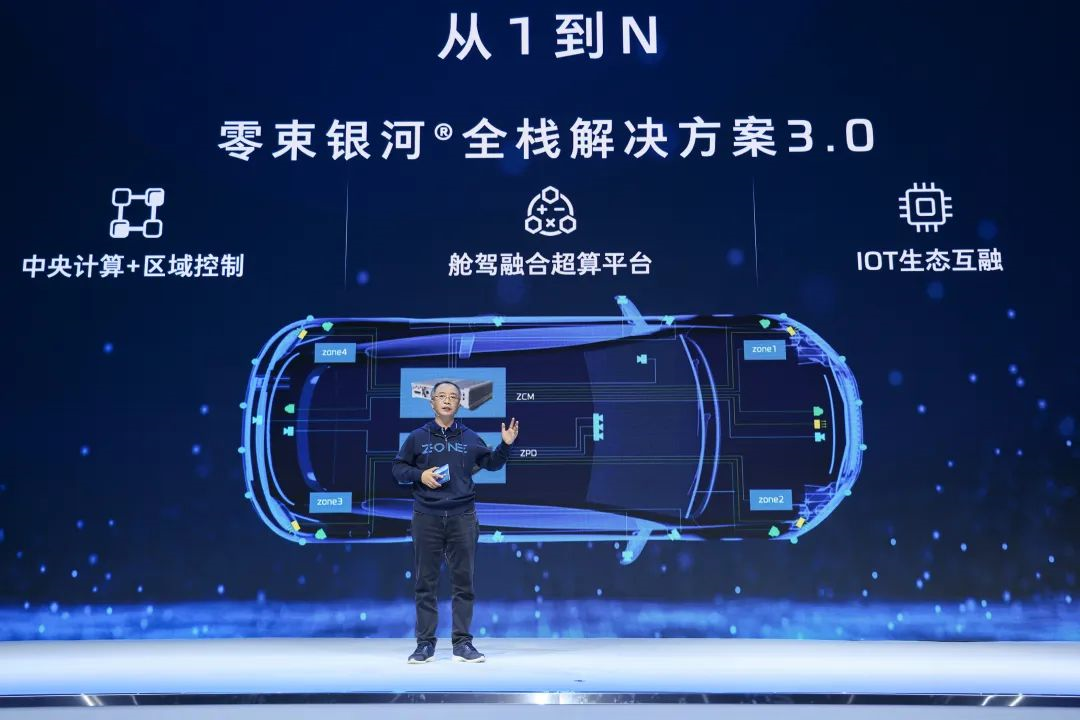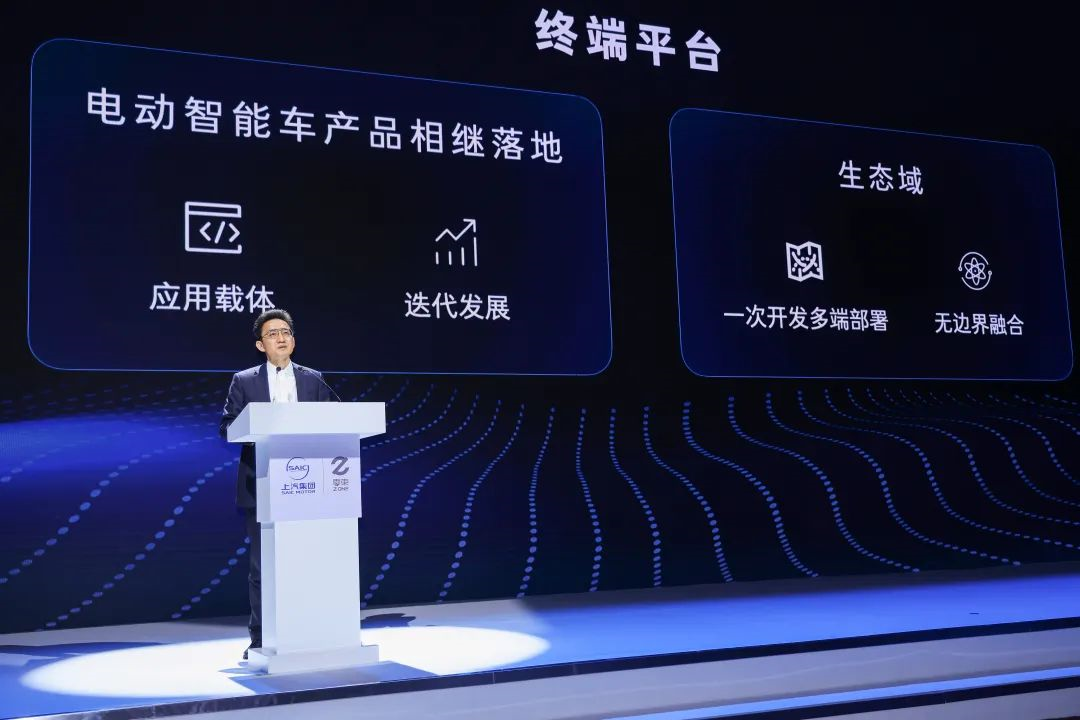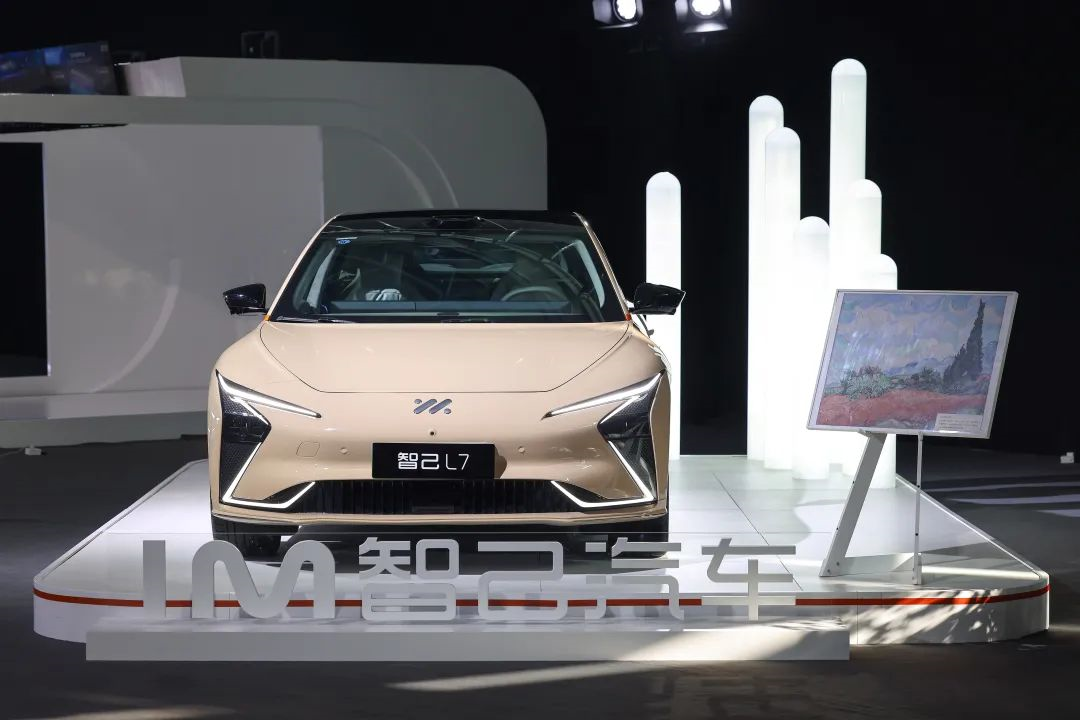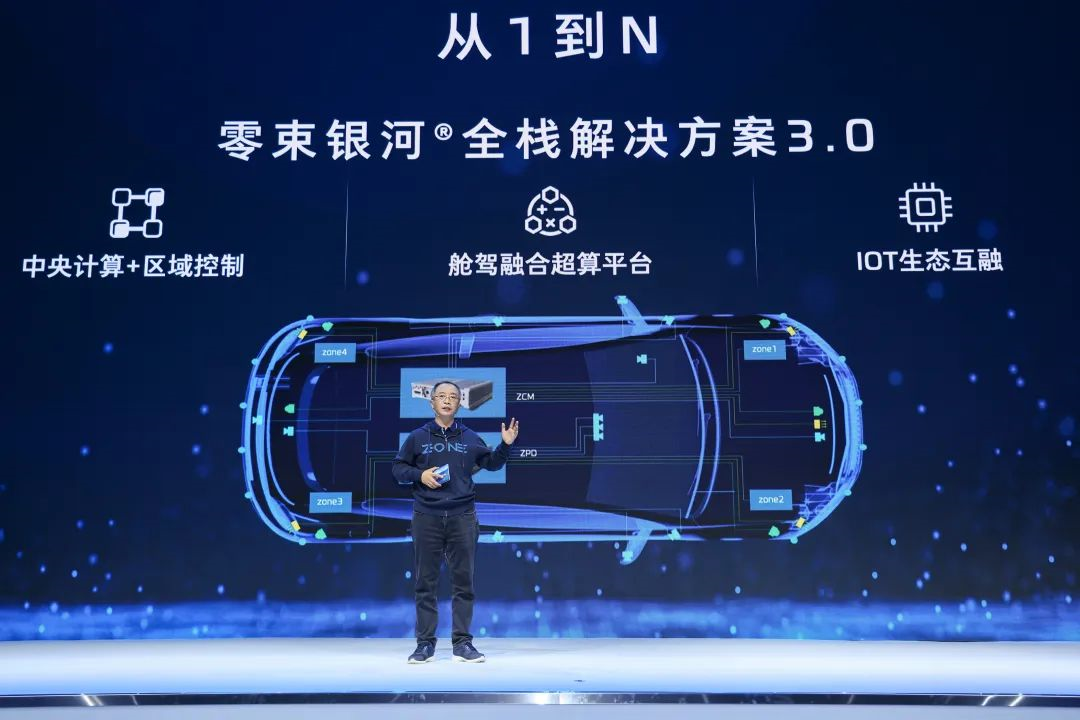Author: Shiyun Zhu
Editor: Kaijun Qiu
“We are glad we survived. Hopefully, we can meet again next year.” Li Jun, CEO of ZeroToOne Technology, said during his speech at the second SAIC ZeroToOne SOA platform developer conference.
During the first SAIC ZeroToOne SOA platform developer conference last year, ZeroToOne Galaxy intelligent car full-stack solution, including the underlying electronic and electrical architecture, the generalized operating system, and the data closed-loop system of “cloud, management, and end,” was released.
As a practitioner of SAIC’s “data determines experience, software defines cars,” ZeroToOne Technology wants to self-develop the entire stack in the software field, which is the weakest point of traditional automakers.
After a year, ZeroToOne Galaxy Full-stack 1.0 became the industry’s first overall solution for mass-produced vehicles with SOA architecture, and ZeroToOne released ZeroToOne Galaxy Full-stack 3.0, including the vehicle operating system, domestic smart cabin/driving domain control, cabin/driving integration computing platform, and “ecological domain.”
Currently, while “SOA architecture” and the “cloud, management, and end system” have become new technology buzzwords in the auto industry, and Huawei is flourishing, on the other hand, the mass-produced ZeroToOne Galaxy Full-stack 1.0 smart vehicles, such as the IM L7 and Feiyue R7, have just been launched. Similarly, Volkswagen, which also wants to self-develop the whole stack, chose Horizon as its strategic partner in China.
The process from strategic selection to market validation is long and brutal. Now that SAIC has mastered software technology, in the face of the fast iteration of automotive software and the constant changes in technology route, can SAIC grasp this core competency?
How many coders do you need to turn on the wiper?
How many coders do you need to program the “automatic wiper when it rains” function?
In the past, this required linking 20-30 communication nodes (parts/components) in the car, using hundreds or even thousands of lines of code to achieve this seemingly simple function, which only appeared in high-end luxury models.
Today, this function will appear more and more in mid-range production models. Because as SAO(Service-Oriented Architecture) is installed in the vehicle, implementing this function will only require logical association of several related capabilities packages according to the causal relationship of “discovering rain” and “starting the wiper.” The wiper may even “dance” along when KTV is playing, all without the need for coders.
Low-code, Low-operation Threshold, Rapid Implementation, and Efficient Iteration driven by the SOA architecture will shape the future of “software-defined cars”:
Cars are defined by user needs rather than part combinations;
Vehicles can meet users’ ever-changing functional requirements at a low cost, high efficiency, and continuity.
This is why SAIC, Changan, GAC, Volkswagen, Mercedes-Benz, and others are making significant investments in a series of SOA architectures for entire vehicles, such as the Galaxy, SDA, Star, SSP, and MB・OS, which represent their “ambitions”:
OEMs that are used to integrating hardware components (automakers, for example) naturally want to have the ability to integrate “software components” to eliminate the inherent limitations of component properties and iteration cycles.

For example, the ball game in the RisingAuto R7 cockpit is controlled with the brake, throttle, and steering wheel; the two “horns” above the head of the ZhiJi L7 can be replaced with a laser radar and the internal chip can be changed from the 30TOPS Nvidia Xavier to the 524TOPS Orin in the future.
Such capabilities were unimaginable in the past because the vehicle control system requires extremely high security and usually employs hard isolation in signal transmission, which does not interact so deeply with the intelligent cockpit that emphasizes comfort.
Adding or removing sensors and changing chips requires a significant transformation in the EEA and software architecture, where a small change can lead to a significant impact. For example, the software architecture research and development conducted for the extremely cost-effective Krypton 001 to replace the high-end Snapdragon 8155 chip amounted to a staggering CNY 300 million.
“By 2023, we will see large-scale implementation of the entire-vehicle-level SOA software architecture,” says Wang Qiuyu, consultation director of the Easeware RuiChi Connectivity business unit, according to Electric Vehicle Observer.## How to achieve software mass production capability?
“Mass production is one of our core competencies.” said Meng Chao, CTO of Zero-Spec Technology, to Electric Vehicle Observer.
The Zero-Spec Galaxy full-stack 1.0 released in April 2021 includes the centralized electronic architecture (EEA), SOA software platform, OTA and network security, data factory, and cross-domain integrated end-to-end digital experience products.
If we only look at the use of centralized EEA architecture and SOA, it is not unique to the Galaxy.
In comparison to top new car manufacturers like Tesla, the first batch of products have achieved 4-5 domain-controlled integrated EEA architecture; GAC and WM have also launched SOA products that can freely combine multiple body parts.
But before the Zero-Spec Galaxy, there were no mass-produced vehicles based on the whole car-level SOA architecture.
“GAC and WM are based on an early SOA model with linkage and free encapsulation formed by adding a few chips to the cockpit and intelligent driving domain via Ethernet gateways.”
A SOA architect told Electric Vehicle Observer, “However, the whole car-level SOA platform is based on a new centralized domain control foundation for the vehicle, and then constructing an SOA cross-domain collaborative service framework. “From Zero-Spec’s EEA architecture perspective, it is whole-car level (rather than within or among several domain controls).”
But achieving the whole car-level of SOA is not an easy task.
SOA is not a tree without roots and requires the deployment of Ethernet communication based on switch communication. Ethernet has the advantages of accessing multiple node devices and high communications speed. The communication speed of the automotive CAN bus is often in the range of 125Kbps-500Kbps, while Ethernet can achieve hundreds of megabytes or even gigabytes.
On the other hand, the CAN bus communication has the low latency advantage that the Ethernet is difficult to achieve, which is why the automotive has always used high real-time communication to ensure safety.
Therefore, when SOA is applied in safe locations such as the cockpit, the latency problem of Ethernet is “not significant.”
But when it comes to covering the entire vehicle software architecture, it is necessary to find a balance between applicability, reliability, and safety.
The designer needs to have both the whole car and software system capabilities to rebuild the bottom-level EEA architecture, the intermediate software layer and the vehicle-to-cloud data closed-loop three-layer system from scratch.
“`
“Today, the Zero Architecture Galaxy Full Stack 1.0 has been put into mass production on real vehicles. We worked hard for two or three months before the start of SOP (the whole vehicle begins mass production).,” said Zu Sijie, vice president and chief engineer of SAIC Group, with emotion during an interview after the Zero SOA Developer Conference. “Because software will have bugs, making software is completely different from our traditional car methods in the past, and we need to solve various challenges.”
In 2022, the IM L7, which is equipped with the Zero Architecture Galaxy full-stack technology base, and the RisingAuto R7, which is fully equipped with the Zero Architecture Galaxy full-stack technology solution, have officially gone on sale.
“The application and stability of the Galaxy whole vehicle SOA platform have been verified by mass production,” said Meng Chao. “Communication forms such as SOA services are easy to design, but the later engineering implementation and performance, scheduling, fault tolerance mechanisms, end-to-cloud integrated abstraction, etc. are all explored in the actual (mass production) process. This is the future core (selling point), and the difference between mass-produced platforms and technology design.”
On these mass-produced models, Zero has implemented a series of core self-developed technologies, including centralized computing, Zone area centralized management; support high-bandwidth, low-latency backbone network design, support TSN (Time-Sensitive Network), DDS (Data Distribution Service) protocol, intelligent energy consumption management.
In addition, end-to-end implementation of data closed-loop support digital product design, based on data remote diagnostic services and OTA (Over-the-Air) rapid iteration; end-to-end implementation of functional distribution layout, can achieve flexible iteration and low operation and maintenance costs.

Is this mass-produced whole vehicle SOA architecture advanced?
Recently, the Electric Vehicle Observer test drove the IM L7 and found that its voice assistant can directly start the supercar mode and automatic parking function during high-speed and low-speed driving.## The Battle of Ecological Integration from 1.0 to 3.0
In the smart cockpit, voice applications can control relevant functions in the body control and intelligent driving domains. Even new players in the market cannot currently call such highly secure functions, as the L7 underlying technology covers a wide range of features.
Last year, SAIC gained an advantage in the battle of software capability transformation. However, competitors are catching up quickly. In November, GAC released the Star Drive EEA architecture, which supports “software-defined cars” and will be used on GAC Aion’s new high-end car series in 2023. In August of this year, Changan officially displayed the SDA architecture, which features “hardware pluggable, scene programmable, ecological adaptability, and system self-evolution” technology characteristics, and launched the “Zhuge Intelligent” smart brand based on the SDA, as well as the CD701 prototype car.
Currently, the development of service-oriented SOA architecture has become a consensus in the automotive industry. In 2023, the entire vehicle-level SOA architecture will be mass-produced and installed, fundamentally innovating users’ experiences in intelligence.
In the trend, SAIC hopes to convert its technology advantage in the “software-defined car” field into an ecological advantage through deep cooperation with other hardware and equipment suppliers. “The transformation of the automotive industry is electricization in the first half and intelligence in the second half, but the final outcome is always ecological integration. The intelligent connected vehicle should become a large ecosystem, similar to smartphones. The smartphone itself is not important, but its ecosystem is,” said Zu Sijie. Therefore, SAIC is cooperating intensively with industry ecosystems represented by chips, operating systems, and external IoT device manufacturers.
Essentially, software capability determines the growth of smart cars, while hardware configuration determines the ceiling of growth. Working with all parties in the industry chain can help improve the overall operation efficiency of the automotive system and better define products with a ceiling.The cooperation results will be reflected in the Lingtu Galaxy Full Stack 3.0.
Lingtu Galaxy Full Stack 3.0 consists of four intelligent products: Lingtu Galaxy® Intelligent Vehicle Operating System ZOS, Lingtu Galaxy® Intelligent Driving Calculation Platform ZPD, Lingtu Galaxy® Intelligent Cabin Calculation Platform ZCM, and Lingtu Galaxy® Cabin-Driving Fusion Calculation Platform ZXD.
The significant feature of Lingtu Galaxy Full Stack 3.0 is the seamless integration of intelligent experiences between humans, vehicles, and the environment, enabled by the high-performance supercomputing platform with central calculation and regional control, cabin-and-driving fusion, deep integration of IoT ecological learning, and iterative technology.
ZOS fills more gaps and strengthens critical details in the current SOA platform architecture to form an intelligent automobile operating system that spans chips and clouds. It features deterministic communication and scheduling, high-function security, network security, and open-source characteristics.
ZPD’s Intelligent Driving Calculation Platform is equipped with domestically-produced high computing power chips, and it includes the BEV mid-fusion perception technology developed jointly by Lingtu and Horizon Robotics, which can support autonomous driving in complex urban scenarios.
The intelligent cabin domain control ZCM introduces the “ecological domain” technology, which, through its extensive compatibility with underlying data transmission, hardware and software frameworks, and labeling protocols, enables smart devices such as IoT and different brands and models of smartphones to be freely connected.
“We hope to conduct in-depth research and development on the core modules ourselves. Still, in the fully competitive and scaled field, we will work with partners to scale up the integration,” said Li Jun, “Our strengths lie in the regulation and integration ability of large systems.”
“We also need to ensure that these integrations are good and free of issues, and this is our core competency that we are focusing on building,” said Zu Sijie.
How to establish sustainable new R&D capabilities
“The most significant pressure on R&D is structural transformation, and the pressure is enormous,” says Lu Yong, Assistant President and General Manager at SAIC’s Innovation R&D Center, in an interview with Electric Vehicle Observer.
The clear direction of the SOA and ecological strategies is just the first step in transformation. To sustainably control core technology, we must adapt to the new knowledge and research and development mechanisms of the “software-defined automobile” to support continuous technological and demand changes.In March, SAIC announced the integration of its five major information technology centers (software, artificial intelligence, big data, cloud computing, and network security), passenger car technology center, and overseas innovation centers (UK, Israel, North America) into the “SAIC Group Innovation Research and Development Institute”.
It is worth noting that the institute not only integrates technical capabilities but also begins a complete transformation of research and development positioning and functions.
“The integrator of vehicle products, the source of advanced technology, and the transformer of technology commercialization.” Lu Yong said, “Because we need to serve multiple brands, we are no longer a simple cost center but need to transform into a value center.”
The so-called “value center” means to create real brand and commercial value through the implementation of technology in the whole vehicle project.
In other words, it is no longer about what technology the group has and what technology the brand uses. Instead, it is about what technology the brand needs and what technology the group should have.
To this end, the SAIC Innovation Institute realizes “value” through top-level mechanism reform.
One is to “tie” the results with individuals. Incubate internal team entrepreneurship and technology innovation, mature and commercialize them, and ultimately use patent revenue as the incentive source for corresponding intellectual property research and development engineers.
The second is to “tie” technology with customers. Although they are all within the SAIC group, Zhi Ji, RisingAuto, Roewe, and MG are customers and partners of the innovation institute with commercial implications.
For example, RisingAuto and the Innovation Institute have established joint centers for intelligent driving, data, and design innovation. RisingAuto’s R7 intelligent driving and smart cockpit technologies come from the joint innovation center.
“We have corresponding interests tied and shared,” Lu Yong said, “Through internal equity reform, the increase in market value or value brought by us and the brand’s co-creation will give our R&D team corresponding virtual equity (incentive) reform.”
Currently, the SAIC Innovation Institute has formed a research and development team of 5,000 people, and in the future, it will continue to expand to tens of thousands of people.
Obviously, compared with the fossil fuel era, in which the product form and technology path have been solidified, the electric and intelligent era requires research and development technology centers to more closely fit the terminal demand and ever-changing technology path, and to do technology for the market.This is a sustained battle for both traditional car companies and new carmakers.
For SAIC, it is not enough to just master the core technology.
The technology module library of the Innovation Center is built on the concept of “shelves”. Its subsidiary technology companies such as Lingstream and JieHydro have external financing and innovative technologies. Lingstream’s intelligent driving domain control emphasizes its cost-effectiveness, reflecting SAIC’s hope that future technology can take root outside the group.
“The technology foundation is the basic work for the diversification, enrichment, and differentiation of future products. At this stage, we mainly focus on the integration and iteration of IM and RisingAuto full-stack technologies. In the future, our technology foundation can serve not only various brands but also outside the industry.” said Zu Sijie at the end of the interview.
–END–
This article is a translation by ChatGPT of a Chinese report from 42HOW. If you have any questions about it, please email bd@42how.com.
